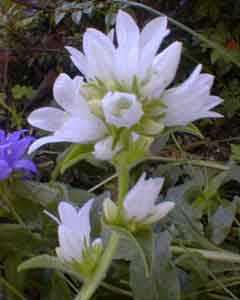
'Crown of Snow'
Clustered Bellflower; or,
White Danesblood
"I know that summer's flower and leaf
And shine & shade are very brief."
-Elizabeth Barrett Browning
(1806-1861)
(1806-1861)
This German seed-strain cultivar 'Schneekrone' is called 'Crown of Snow' or 'Snow Crown' in English, alluding to big pure white flowers in late spring & early summer.
It can be floppy in shade or in warm rainy zones, but looks interesting even at a flop, so that staking is a matter of personal taste rather than a necessity. In somewhat sunnier locations in chillier climates the flower stems rise straight up to as high as two feet, above somewhat shorter spreading clump of dark green basal leaves. The stalks are shorter than most Campanujla glomerata varieties, & the clustered flower heads are larger.
A temperate flower, it may not do well above zone 8, but is extremely cold-hardy & has been grown even in zone 2, though easily only to zone 4. Here on Puget Sound it blooms extremely well even in a considerable portion of shade, though it is not likely to grow upright in shadier positions.
In perfect conditions it can become a mite aggressive. If a clump becomes too large, it can be divided either spring or autumn. It can also be cultivated easily from seeds sewn in coldframes after last threat of frost, or from basal cuttings taken in spring, transferred to their permanent garden locations in late spring or early summer.
The Eurasian species is sometimes called Dane's Blood, Dane's-blood, Danesblood, or Daneweed, a name shared with Dwarf Elder (Sambucus ebulus). The name derives from an old belief that these plants sprang from the blood of Danes who fell in battle.
As an edible campanula, the sweetish flowers can be used in mixed salads, & young tender leaves are tasty enough to be eaten on their own, fresh with a little vinegarette.
C. glomerata dahurica 'Superba'